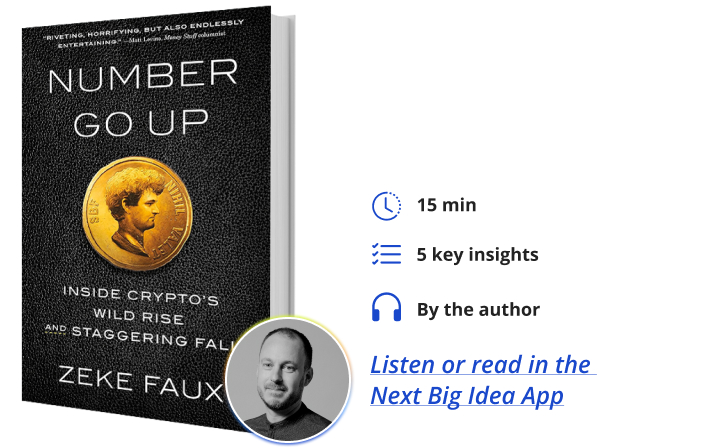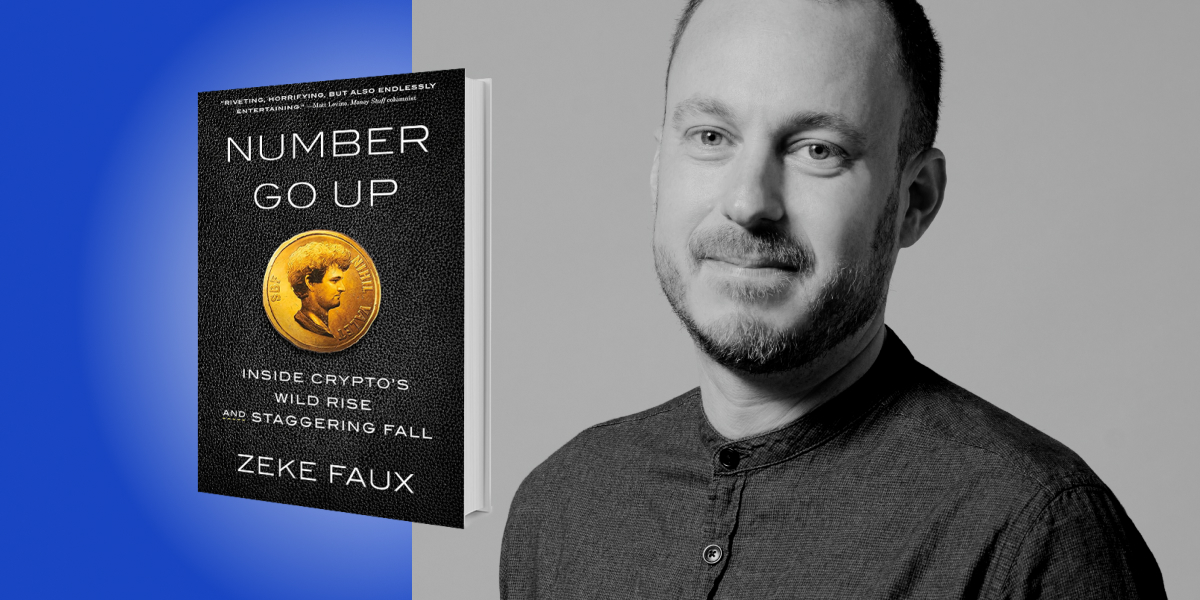Zeke Faux is an investigative reporter for Bloomberg Businessweek and Bloomberg News and a National Fellow at New America. He’s a winner of the Gerald Loeb Award and the American Bar Association’s Silver Gavel Award and a National Magazine Award finalist.
Below, Zeke shares five key insights from his new book, Number Go Up: Inside Crypto’s Wild Rise and Staggering Fall. Listen to the audio version—read by Zeke himself—in the Next Big Idea App.

1. The crypto bubble wasn’t as dumb as you think. It was even dumber.
I got into the crypto world the same way a lot of people did—a text from a buddy telling me I should invest in something called Dogecoin. (Actually, he called it “doggy coin,” but I knew what he meant.) I thought it was dumb, but he made a bunch of money on it. I needed to know what was behind all these random cryptocurrencies that were going up and up. Their total market value hit $3 trillion at one point. It couldn’t all be a dumb joke, could it?
But wherever I went, when I pulled back the curtain to see what was really going on, I’d see there was nothing there but hype and empty promises.
Take, for example, Axie Infinity. It was a crypto game—a sort of Pokémon knockoff in which players bought monsters and earned crypto in battles. It went viral in the Philippines, and crypto bros hyped it as a demonstration of what they called web3: an internet in which users own their data and it’s tracked on blockchains, rather than controlled by big tech companies like Facebook.
Sounds good right? But when I went to the Philippines, I found nothing but misery. Regular people had taken out loans to buy into this game and lost everything when the bubble inevitably popped.
2. A good story goes a long way.
One of the most fascinating characters I met in the crypto world was Sam Bankman-Fried. He was a 29-year-old with a shock of messy, curly hair, who always wore khaki shorts, New Balance sneakers, and a t-shirt advertising his company FTX, even when he was on stage with world leaders.
He was worth at least $20 billion, but he claimed he’d only gotten rich so that he could give it all away. He drove a Toyota Corolla and liked to sleep at the office on a beanbag chair next to his desk. He said FTX was the future of finance.
“That story turned him into one of the richest and most powerful people in the world.”
It was an irresistible story. The problem was that it was not true. While the media, politicians, venture capitalists, and investment bankers lauded him as a benevolent prodigy—a Warren Buffett or J. P. Morgan for the digital age—he was secretly embezzling billions of dollars of his customers’ money and blowing it on bad trades, celebrity endorsements, and a real-estate shopping spree in the Bahamas.
But because his story sounded so good, he was able to avoid scrutiny during his meteoric rise. That story turned him into one of the richest and most powerful people in the world. Only a run on his exchange, FTX, revealed the fraud at its center.
3. If you don’t understand something, maybe it just doesn’t make sense.
Crypto bros were great at convincing people that if they didn’t “get” crypto, it was because they just hadn’t studied the blockchain hard enough. One of the first people I met in the crypto world tried this on me. His name was Alex Mashinsky and he ran a company called Celsius that amassed $20 billion in assets.
Mashinsky told me that users could deposit crypto with him and earn rates as high as 18 percent a year. He said that the company loaned out money too, but at low rates. It sounded like a great way to lose money, or possibly a Ponzi scheme.
But Mashinsky told me I just didn’t get it. Traditional banks were making money hand over fist, and just choosing not to pay that out to their customers. He said that Celsius was actually safer than JPMorgan. “Somebody is lying,” Mashinsky said. “Either the bank is lying or Celsius is lying.”
Mashinsky was lying. In July 2023, he was arrested and charged with orchestrating a massive fraud.
4. Being “cool” is a flimsy foundation for a company.
A lot of crypto was pitched not so much as an investment, or a technology, but as a way to get in on the cool new thing. During the crypto mania, one of the “coolest” things in crypto was the Bored Ape Yacht Club. It was a set of ten thousand images of apes sold as NFTs. Justin Bieber, Jimmy Fallon, and Paris Hilton all had them. Celebrities made their Apes their profile pictures on Twitter. Some cost more than $1 million. Venture capitalists invested in the company which made them at a $4 billion valuation. Bear in mind these are literally ugly cartoon images of apes wearing silly costumes.
“A fad is not a sound basis for a company.”
I decided to join the club to attend an Apes-only festival called ApeFest. The cheapest ones cost $20,000. That wasn’t an easy conversation to have with my wife. What I found at ApeFest was a bunch of drunk and stoned dudes standing around. Not even performances by Eminem and Snoop could rescue the desperate vibe.
The hype couldn’t last. Ape prices, predictably, crashed. A fad is not a sound basis for a company.
5. It’s easier to make up lies than to disprove them.
There are thousands of cryptocurrencies, each of them supposedly revolutionary.
Any one of them would have probably been good fodder for an investigative story. But I realized there was no way I was going to have time to investigate each one of them before the bubble popped. It reminded me of a maxim called the “bullshit asymmetry principle,” coined by an Italian programmer, Alberto Brandolini. “The amount of energy needed to refute bullshit is an order of magnitude bigger than to produce it,” he wrote in 2013.
To combat this, I started putting the burden of proof back on the promoter. Ask them, what does your new thing do? Can I see it in action? Can I talk to the customers? Crypto bros were never able to give me satisfactory answers. And starting in the summer of 2022, the bubble did pop. Coin prices returned to earth. Many of the biggest companies in crypto were revealed to be frauds. A technology without real-world utility cannot succeed. A mania built only on hype can’t last.
To listen to the audio version read by author Zeke Faux, download the Next Big Idea App today:































